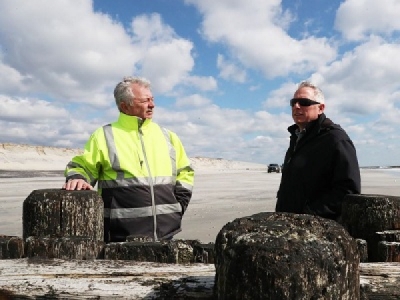
Posted on March 13, 2018
By Michelle Brunetti, PressofAtlanticCity.com
A 30-foot-high tricycle dubbed the Crab slowly rolled into the waves off the beach in the Holgate section Friday, driven by a technician in a cab high atop it. He was taking GPS measurements of the sand under the vehicle’s giant wheels.
On the beach, two engineers sat waiting in a truck, one in a wetsuit in case the vehicle toppled and the driver needed rescue.
About 100 feet out, the huge Coastal Research Amphibious Buggy rolled onto a sandbar that practically lifted it out of the water.
The sandbar was created by sand eroded from the beach by the two nor’easters that recently hit the shore within a week. The storms did some of their worst damage here, said Robert Giovannetti, construction management specialist with the state Department of Environmental Protection’s Bureau of Coastal Engineering.
The contour of the beaches changed, but not in a way that threatens the dune system, he said. The water only affected dunes at the far southern end of Holgate, near the border with the Holgate Natural Area of the Edwin B. Forsythe National Wildlife Refuge.
“Some people say we lost the sand,” said Giovannetti, who has conducted post-storm assessments on Long Beach Island for 25 years. “But you can see it’s sitting offshore, creating a natural sandbar. It’s actually still within our template and natural beach system.”
It is also absorbing some of the waves’ power, further protecting the beach, said BCE Project Manager Chris Constantino.
While the work of The Crab isn’t part of the post-storm assessment — it is taking measurements for contractor Great Lakes Dredge and Dock Co. as part of a dredge and beach replenishment project that is just finishing up — the data collected will help the state understand how the shoreline changed.
Giovannetti recently reported most LBI beaches sustained minor to moderate beach erosion with just a few places actually seeing damage to dunes.
That was the case along the entire New Jersey coast, the DEP reported.
In addition to Holgate, more serious erosion was limited to Rhode Island Avenue in Atlantic City, 88th to 91st streets and at the southern inlet in Sea Isle City, and Second to Eighth avenues in North Wildwood, said DEP spokesman Larry Hajna.
The state was fortunate not to see worse beach erosion than it did, Constantino said.
Winds from the west helped to keep high tides from being as destructive as they might have been to the dunes, he said.
The tall dunes that now protect all of LBI were built about two years ago by the U.S. Army Corps of Engineers, and if not for them, the damage in general would have been much worse, Constantino said.
In parts of Holgate, before the Army Corps project, “every storm I would come and take pictures of the ocean going under houses,” said Giovannetti. Now the water stays on the ocean side of substantial dunes.
He said he visits about 30 of the same locations after storms to take photos and determine the extent of erosion or damage.
Hurricane Sandy in 2012 devastated southern LBI, he said, and that convinced residents a substantial dune system was needed.
Constantino and Giovannetti will start a new project on LBI in about two weeks. It is to repair the beaches in Harvey Cedars, Brant Beach and Surf City to their original Army Corps profile, said Giovanetti.
They also are helping Long Beach Township plan for a new jetty where the remains of an old wooden jetty now sit, separating the developed part of Holgate from the Natural Area.
The jetty has to be just the right size, said Constantino. Too large and it will prevent sand from drifting south onto the Natural Area’s beaches. Too small and it won’t help keep enough sand on the developed beaches.
“People have no idea all this goes on in winter,” Giovannetti said. “They show up June 15 and say, ‘Oh, my beach is perfect again.’”
In North Wildwood, however, erosion presented a more pressing problem.
“We certainly have an emergency situation,” said Mayor Patrick Rosenello. “The high tide (during Wednesday’s storm) washed everything away to the end of the bulkhead at Sixth Avenue.”
He said the city’s priorities are to keep the ocean from breaking through where the bulkhead ends and to keep high tides from eating away at dunes farther south.
Crews are going out at low tide to bulldoze sand back up to block the end of the bulkhead, the mayor said. The city has ordered more steel to extend the bulkhead to Seventh Avenue.
“It will take two weeks to get the additional material to do another block,” he said. So the emergency sand bulldozing will continue during that time.
After the bulkhead is extended, the city will focus on getting the seawall built from Second to Seventh avenues, he said. That will involve placing walls of large boulders on the ocean side of the bulkhead.
And then more sand will need to be moved to the northernmost beaches.
“Just to get back to where we were last summer, we need 500,000 cubic yards,” said Rosenello.
The most sand the city has ever moved by truck was 200,000 cubic yards, and that took 30 days, he said.
“Most likely we will be trucking in the spring to try to put a Band-Aid on it,” said Rosenello. “But we are getting beyond where trucking is a feasible option.”
So he hopes to be able to get some help from the Army Corps to pump some sand, he said.
Source: pressofatlanticcity





